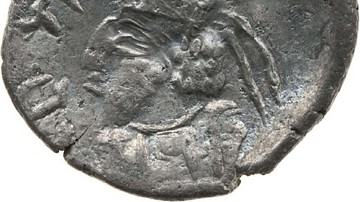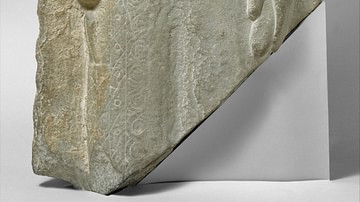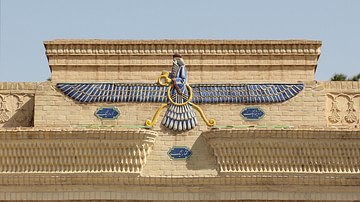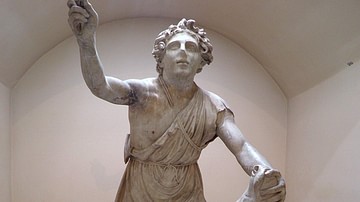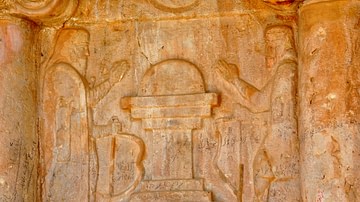It is rare when a new find creates renewed interest in an old subject. Here, the new find is a leontocephaline (lion-headed) figure of unknown provenance, weighing 5.8 kg and 37 cm in height with a width of 14 cm. Its base is partially broken, so it is unclear if the figure was standing on a globe, an expected position, or not. The main figure is a standing, naked leontocephaline figure with only a loin cloth in the front and two closed wings on the back; from the front, the wings appear as a mantle around the figure, but they are clearly wings, probably belonging to an eagle.
A serpent, bound around the figure's ankles and continuing up to his chest in five folds and through his back, finally rests its head on top of the lion's head. The leontocephaline figure holds a cylindrical object in his right hand, which is raised above the shoulder and folded over it to rest the end of the object on the right shoulder, and is also artistically connected to the head to support the weight of the arm and the cylindrical object. The left hand of the figure rests on what appears to be the handle of a sword on the left side of the figure, although the actual scabbard is not visible, disappearing into the folds of the serpent. At the back, below where the wings of the monster meet, there is a hole which suggests it was hooked to a wall or a shelf from the back. Otherwise, the statue is in very good condition and a new addition to the iconographic typology of the beast, which is known from the Mithraic religious current in the Roman and the Mediterranean world and perhaps the Caucasus.
Mithraism is among the most important mystery religions in the Eurasian world. This cult, with its origins in the Iranian world, was centered around an Indo-Iranian deity known as Mithra (from Avestan Mithra-; c.f. Sanskrit Mitra). Mithra was primarily a god of contracts, by whom people swore and took oaths. In the Avesta, the sacred hymns of Zoroastriansm, Mithra's hymn (Mihr-yasht) is the longest and often considered to be the most interesting, as it details the pre-Zoroastrian importance of the deity who is then adapted into the new religion of Prophet Zarathustra. Besides presiding over contracts, the secondary and tertiary functions of Mithra in the Indo-Iranian world were his identification with the sun and love/friendship – the latter itself an extension of the contract function.
This deity was also important in Armenia and the Caucasus, where it became well-known starting in the Achaemenid period. Mithra's cultic features such as Cautes and Cautopates (the twin torch bearers), the cave, and the birth of Mithras from a rock are in fact mainly associated with the Armenian world and its manifestations, such as the Epic of Sassoun. We hear of Roman contacts with the cult of Mithra in Armenia through the stationing of the Legio XV Apollinarius, first created by Octavian and sent to the East. This legion was then stationed in Armenia during the emperorship of Nero. Mithra must have been taken to Rome, where the Cult of Mithra became the most important mystery religion in the Mediterranean basin and the rest of the Roman Empire.
There were hundreds of Mithraeums, which are caves or cave-like structures where a statue or fresco of a young boy with a “Phrygian” cap in the process of slaying a bull was featured as the main iconography. Men broke bread and drank wine in these caves and believed that Mithra (the young boy) comes to earth to sacrifice the bull to absolve humanity of its sins and then ascends to heaven. The cult indeed had many features which were borrowed by Christianity. Due to its peaceful nature and with the triumph of the latter religion, Mithraeums were either closed down without being molested or were simply turned into churches, signifying the victory of Christ over the pagan traditions. The sacred topography, though, remained the same.
Another iconographic representation was also present in many, but not all, of the Mithraeums: the statue of a lion-headed man with wings (sometimes closed and sometimes opened), who usually is holding a staff or a thunderbolt in one hand and in his other hand he holds a key (sometimes in both hands), a staff, or a torch. A snake usually coils around the body of the figure and its head appears from the back, resting on top of the lion's head. At times there are zodiac signs placed on the body or vestments of the leontocephalinic figure. The lion's mouth is open and usually a hole is seen between the fangs of the lion.
The identification and function of the statue, which was no doubt a deity, are subject to intense speculation. One of the early and important scholars of Mystery religions, Franz Cumont, supported the idea that the leontocephaline figure represented the Mithraic Kronos, whose Iranian form is Zurvan, the God of Time in the Zoroastrian tradition. Some scholars such as G. Widengren, Vermaseren, and Clauss accepted the suggestion that the figure represents Zurvan, the god of eternal time. In this myth, Zurvan became the father of both Ohrmazd (Av. Ahura Mazda “the Wise Lord”), the supreme deity of Zoroastrianism, and Ahriman (Av. Angra Mainiyu), the Evil Spirit and Ohrmazd's main adversary.
However, another interpretation has rightly gained favor over the identification of Zurvan. In 1953, J. Duchesen-Guillemin suggested that we were not dealing with Zurvan, but rather the Evil Spirit himself, i.e. Ahriman. This identification is now widely accepted, and there are several reasons why identifying the figure as Ahriman in the context of Mithraic belief, and perhaps beyond, might make sense. In terms of iconographic precedence, one can point to Mesopotamian reliefs from Assyria. The lion-headed image, for example, is seen in the reliefs from the time of Senacherib from Kuyunjik (705-681 BCE), providing an early model.
Additionally, not only in Zoroastrianism but also in Manichaeism the descriptions of the Evil Spirit or the Devil have similarities to our figure. For example, R.C. Zaehner identified the figure not with the Ahriman of the Zoroastrian tradition, but with the Ahriman of the devil-worshippers. This Evil Spirit according to Zaehner is depicted as: “the source of power and riches, the Prince of this World, who would prevent the soul from rising up again to its true home, which is the Endless Light of heaven”.
The gaping mouth of the lion, according to scholars of mystery religions, is a specifically Mithraist feature, functioning as a way of breathing fire. An inscription from Santa Prisca on a lion-headed statue refers to “lions who burn incense . . . through whom we are consumed ourselves”. In the Gnostic explanation of the mouth of the serpent, too, the serpent-dragon's mouth is said to be fiery, coming from an icy belly. In Zoroastrianism, lions are demonic creatures and are part of the “wolf species,” created by Ahriman, while serpents are the worst of the Khrafsatars (noxious creatures) who creep on the ground. In a passage from the Muslim bibliophile, Ibn Nadim, he describes the image of the Satan in Manichaeism who has the head of a lion and wings. However, there are further details that differ from the complete description of our lion-headed figure.
Most interestingly, in Iran in the province of Luristan, a tale recounts the existence of an evil deity which can be translated as the “Lionish-God.” R.C. Zaehner, who saw the manuscript of this tale, provides the following excerpt in which the Lionish-God states:
Behold, I have created the earth and what is in it and all that are living in it. I have created you, I am giving you your daily bread. Your living is in my hands, and your death too…I will excuse you and send you to my paradise if you put your trust in me, and forget about the God who is in Heaven. But you will be cast into Hell for ever if you worship the god who is in Heaven any more. Behold my wrath is going to fall upon you; it is waiting only for an answer from you. Turn you souls from the Heavenly God quickly. Signed – Lionish God. (Zaehner 1967: 29-30)
This could in some ways be corroborated by the symbolism of serpents in the Yazidi mystery cult prominent in northern Iraq and Armenia, as it is depicted on the walls of the sanctuary of Shaikh 'Adi, but is never explicitly mentioned in Yazidi literature. Its function is probably most closely related to the older Gnostic understanding of the black snake as the Destructive-Creator functionary in the world.
Thus, it seems that from the Near East to the Mediterranean, the idea of a leontocephaline figure was often associated with evil. The resonance of these lion-headed figures spreads from the British Isles (York) to southern Europe (Rome), and from Eastern Europe (Pannonia) to the Eastern Mediterranean (Sidon) and North Africa (Alexandria). There are also four of these statues with an inscription in Latin, stating that this figure is Arimanius (Ahriman).
The lion-headed Ahriman thus appears to have had a specific role in the Mithraic cult. Standing on a globe and among the zodiac – although outside its boundary – the symbolism connects the figure to the cosmos outside the zodiac. According to Ulansey, the leontocephaline figure bound by the serpent represented a Platonic world-soul and marked the ultimate boundaries of the cosmos. In this function, the leontocephaline deity represented a concept close to that of Oceanus in Greek mythology. If he is the gatekeeper, then where the lion-headed figure is holding a key, it is because the Evil Spirit then may also be holding the keys of heaven. In a sense the Ahriman of Mithraism kept the souls bound to this world which he ruled over and allowed the humans to reach their spiritual realm.
The function of the leontocephaline man bound by a serpent thus represents a series of related and interdependent mythological and cosmological iconographies in the Near Eastern and Mediterranean world. The precedents of such figures are well established in Mithraic monuments and cultic representations, and related occurrences appear in iconographies of religions and cults concerned with the ideas of Evil Spirits, Gnostic Destructive-Creator gods, and primeval deities. This latest piece provides similar visual functions, which, if genuine and with established provenance, could add to our better understanding and extent of the use of such iconographies. Although in the absence of a proper provenance and art historical placement, it cannot be confidently assigned, the state of the status, its complete provision of the iconographies including the staff, and its possible previous function as a cultic object as evidenced by the presence of the hole in the back, provide compelling evidence for its placement within such an iconographic program.

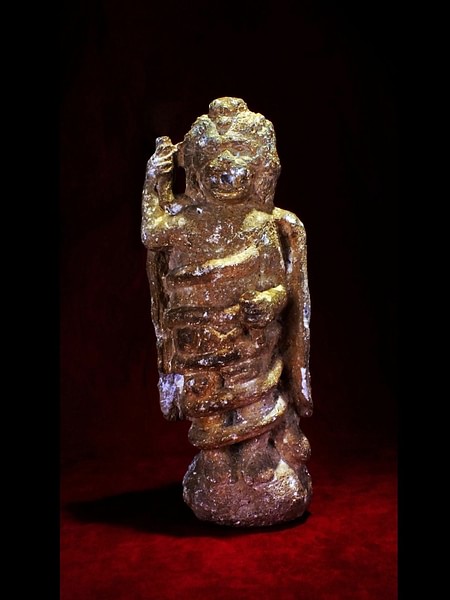
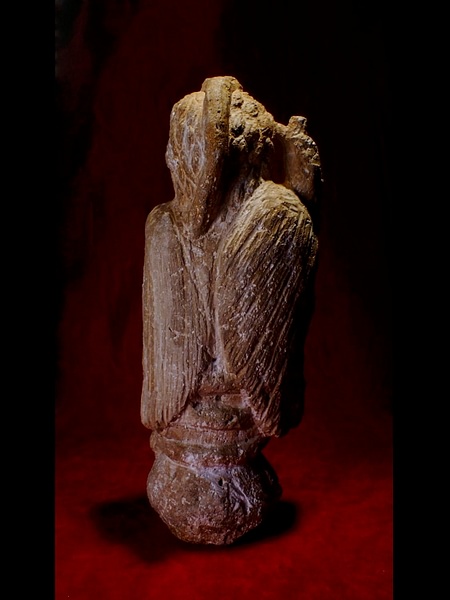
![Ahriman Statue Side View [2]](https://www.worldhistory.org/img/r/p/500x600/2631.jpg?v=1723047966)
![Ahriman Statue Side View [1]](https://www.worldhistory.org/img/r/p/500x600/2630.jpg?v=1613703602)


